Stage Fright – 50th Anniversary
Review by Peter Viney
Originally published at Peter Viney's record collecting web site Around and Around, February 2021. Used with permission from the author.
Stage Fright is the third album from The Band.
I had been completely immersed in the first two albums, Music From Big Pink and The Band, and I remember hearing songs from Stage Fright for the first time. I was in my mum’s garden on a hot sunny day in a deckchair listening to afternoon Radio One. They played two songs: Time To Kill and Just Another Whistle Stop.
Some critics damned it as “third album syndrome” though for me, Side Two was just as good as any side of the two previous albums. In fact, I rate it as better than Side Two of Music From Big Pink. I bought it the day it came out. I had a Dansette record player, and was saving up to buy a proper separates system, and decided never to commit my copy to the Dansette stylus. I took it round to a friend who had a decent deck and we played it daily. He then managed to get an American copy with the separate wrap-around photo.
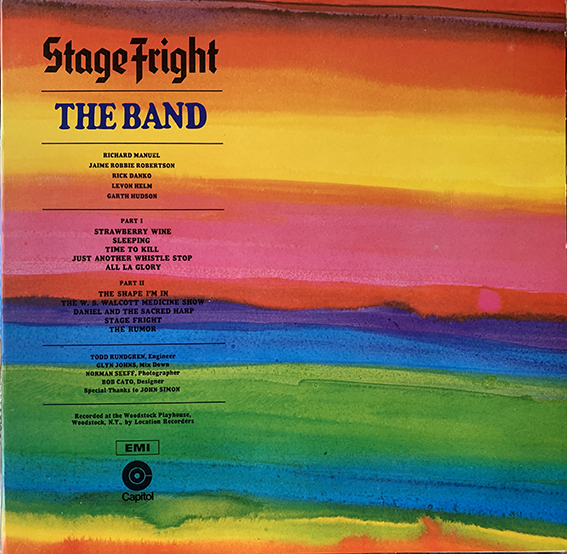
My original British LP from 1970
Both Stage Fright and Moondog Matinee suffered in their UK LP versions because Britain never shrink-wrapped LPs. The sleeves were on display in racks in the shop. The actual discs in their inner sleeves were stored behind the counter. That meant British record labels couldn’t be doing with loose wrap round posters and suchlike. On the other hand we got a gatefold sleeve with the wrap around poster image inside. it’s probably more permanent.
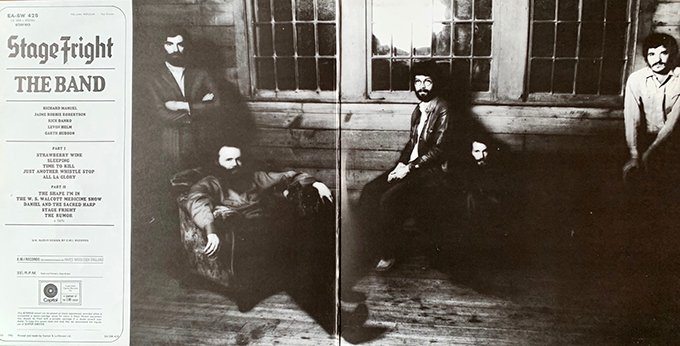
1970 British gatefold sleeve
The 50th Anniversary LP gives us the American version at last.
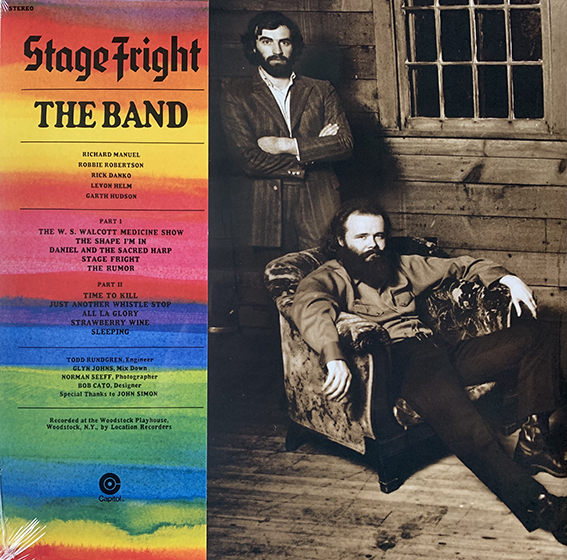
2021 vinyl LP- it is a replica of the 1970 US release with wrap around photo
Stage Fright started a fascinating discussion with a book designer. we were discussing “spine appeal” where the spine of a book stands out. He said, ‘Show me your LP rack!’ I did, and he went straight to Stage Fright (a record he’d never seen before) and said, ‘Perfect LP cover design.’ The rationale? You have friends round (this was the 70s when we still had friends) and you want to put on an LP. You look along all those white spines with tiny lettering, and this one, Stage Fright, leaps straight out at you with its rainbow spine. So you choose it and play it, your friends hear it, and some of them will probably go out and buy it.’ There you are, Stage Fright touches perfection in so many ways … and they had no idea that a rainbow sleeve would catch the eye in the LGBT (etc) 2020s.
On another personal note. When my first son was born, the midwife asked the name. Daniel, I told her.
‘Oh, like the song!’
‘That’s right,’ I said.
‘Daniel is leaving tonight on a plane, I can see the red tail lights heading for Spain…’ she warbled.
‘Oh, no!’ I replied, ‘I was thinking of Daniel & The Sacred Harp.’
When I did The Band for Toppermost, it was just the third selection ever, and in those days we just chose ten tracks. Gradually the site changed to embrace major essays, but back then it was simply a list of ten. I chose Daniel & The Sacred Harp and The Rumor in my selection of ten. I wrote an extremely long detailed article on Daniel & The Sacred Harp for The Band website.
I always thought Side Two was superior, and am vindicated … the 50th Anniversary edition has switched the sides and tweaked the running order to what was originally intended.
Things were getting tense within the Band by mid 1970. Robbie Robertson in Testimony recounts the tale. Hard drugs had taken hold of Levon Helm, Rick Danko and Richard Manuel. They had started failing to turn up for sessions, and Todd Rundgren, as engineer, was bemused to find Levon stretched out asleep during sessions. Robbie has said that was the dividing line, when Levon lied straight to his face about heroin use.
Robbie Robertson: I
couldn’t help reflect what was happening behind the curtain. I wrote The
Shape I’m In for Richard to sing, Stage Fright for Rick, W.S. Walcott
Medicine Show for Levon … all with undertones of madness and
self-destruction.
Robbie Robertson, Testimony, 2016
Levon Helm: It was a
dark album, and an accurate reflection of our group’s psychic weather.
‘Daniel and The Sacred Harp’ was about selling your soul for music.
‘Stage Fright’ was about the terror of performing. ‘The Shape I’m In’
was about desperation. ‘The Rumor’ was about paranoia. Robbie took most
of the credits, played a lot of guitar (it was called The Band’s first
rock & roll album) and generally tried to assume full control of
that part of the process.
Levon Helm & Stephen Davies ‘This Wheel’s On Fire’
So the album was not a happy time. I’m kind of pleased I never knew that in all the first twenty-five or so of the fifty years i’be enjoyed the album.
The running order with two Richard Manuel collaborations and one Levon Helm collaboration placed on side one was “a political decision” in 1970. That has been reversed, and the order tweaked.
Making changes to the main part of a classic album for reissue is unusual, virtually unprecedented … I’m not counting bonus tracks. The other major example was when Paul McCartney remixed Let It Be as Let It Be- Naked to eradicate what Phil Spector had done to the original album. The sticker said As it was meant to be. Paul McCartney dropped two tracks, Maggie May ad Dig It, added Don’t Let Me Down AND resequenced it. This new version of Stage Fright is less radical.
The Original LP
Note that the sides are listed on the sleeve as ‘Parts I and II’ – not ‘Sides 1 and II’
Part I
Strawberry Wine (Helm / Robertson)
Sleeping (Manuel / Robertson)
Time to Kill (Robertson)
Just Another Whistle Stop (Manuel / Robertson)
All La Glory (Robertson)
Part II
The Shape I’m In (Robbie Robertson)
The W.S. Walcott Medicine Show (Robbie Robertson)
Daniel and the Sacred Harp (Robbie Robertson)
Stage Fright (Robbie Robertson)
The Rumour (Robbie Robertson)
Bonus Tracks on the 2000 CD Release:
Daniel and the Sacred Harp (Alternate take)
Levon Helm hums Rick’s fiddle part, Garth plays less and the tambourine and slide guitar are missing.
Time To Kill (Alternate mix)
Glyn Johns Island mix
The W.S. Walcott Medicine Show (Alternate mix)
Glyn Johns Island mix
Radio Commercial
History of releases:
CHART: US # 5 UK # 15
The original idea had been to record a live show at the theatre in Woodstock, The Woodstock Playhouse, but this was nixed by the town authorities, so soon after the Woodstock festival. Because of the ambience and sound of the theatre, The Band rented it empty to use for the recording. This eschewing a formal studio was in line with The Basement Tapes and setting up their own studio in Sammy Davis’s pool house to record The Band.
Todd Rundgren was Robbie Robertson’s choice for engineer, having worked on the first Jesse Winchester album in Toronto with Robbie Robertson and Levon Helm. In Testimony Robbie said that two tracks were done later at studios in the city: a second attempt at W.S. Walcott Medicine Show and the final version of Daniel & The Sacred Harp.
The problem was that on completing mixing the sessions, The Band were off on the Festival Express short concert tour. Having completed the album with Todd Rundgren as engineer / producer, the tapes were sent to British producer Glyn Johns, who had produced Steve Miller’s Children of The Future and Sailor as well as the Stones’Beggars Banquet. Johns had also recorded Dylan at the Isle of Wight, where he met The Band and struck up a friendship with Levon Helm. Eventually Levon called Glyn Johns to say they’d like him to mix Stage Fright.
Apparently, separate complete mixes were done by Todd Rundgren in America and Glyn Johns in London. There is some dispute about who produced which tracks on the final release. Three tracks exist in different mixes on later vinyl copies – it’s said that these three had Glyn Johns mixes which were lost and replaced by Rundgren mixes.
The 1970 vinyl version used three Glyn Johns mixes (The Shape I’m In, All La Glory, The Rumor). All the other mixes were by Todd Rundgren.
It’s clear in retrospect that Rundgren was Robbie Robertsons choice, and Levon didn’t get on with him. The Glyn Johns remix was a further political decision.
The CDs
Yes, I have every CD version … I think …
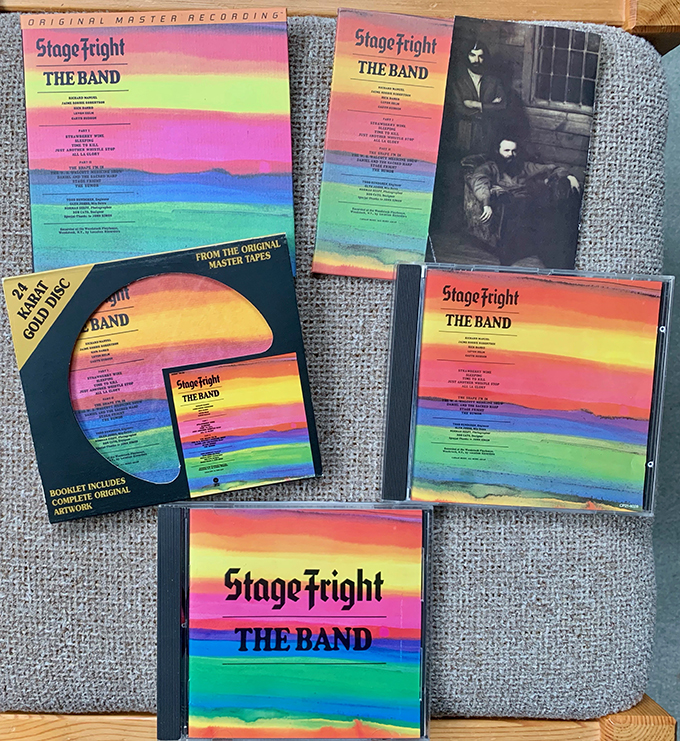
CD versions:
Top left: Mobile Fidelity CD, numbered limited edition (mine is 000201) 2011
Top right: Toshiba – EMI release in replica sleeve, 1998
Centre left: 24K gold disc: DCC Gold Disc GZS 1061 (1994).
Centre right: Past masters CD Japan, 1989
Bottom: first CD release, Capitol, UK, AAD, 1989
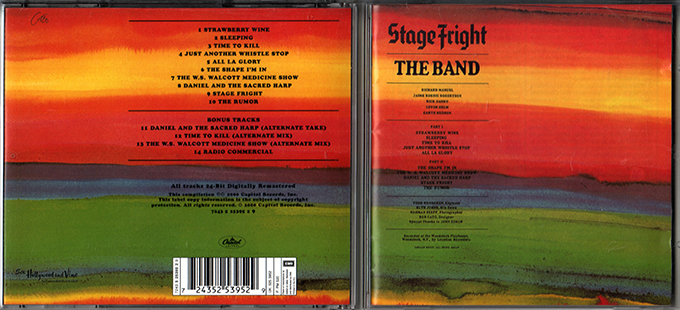
Stage Fright: Capitol Remaster series with bonus tracks, 2000
The CDs are different mixes to the earlier vinyl copies.
Seemingly, the 1990 Capitol CD and the 1994 DCC gold release, used Glyn Johns FIRST mixes throughout- so every mix was different. The original mixes were restored on the 2000 remaster.
- On the first CD of All La Glory you can hear Levon grunting during Garth’s organ solo
- W.S. Walcott ends instead of fading out. It also starts later on the CD than segueing out of the end of Shape I’m In
- On The Rumor there’s an extra overdub of Garth right at the end of Robbie’s guitar solo.
Glyn Johns: Now that’s a very strange thing for
anyone to do if he’s never worked with someone before, for a start;
secondly, it’s bad enough mixing an album you’ve never heard before in
your life, with the guy alongside you to explain how it was recorded,
how it was laid out, how he wants it to sound … Also, I’ve always
thought The Band were incredibly fussy about their sound, they must be
because they’ve always got this amazing sound on record, and I know
they’re very responsible for it. So all of a sudden there’s this
guy phoning me, saying they’re sending the tape, and they’re not coming
with it … The tape duly arrived, and it was a bit of a mess up actually.
I was led to believe it was on an eight-track tape, so I’d booked the
studio at Olympic, Studio One, and when it arrived it was sixteen track …
I ended up at Island in Basing street. Frankly, I was a little bit
disappointed with the material on the album. Also I was a little bit
disappointed with the way it had been recorded, but anyway I went ahead
and mixed it, without anyone there, which was difficult. So it was a bit
of a rushed job and the tapes were sent back to America, and in fact
they only used, I believe, three of my mixes on the album. In fact it
gives me credit on the album for mixing the whole thing, but in fact
that’s not true, and the only reason I know is because when I sent my
bill in their manager phoned me up and said, ‘Well, listen man, we used
three mixes.’ And I said, ‘Well, tough. You’re going to have to pay me
the whole bill. I don’t care. I don’t care if you didn’t use any of
it.’ … I think there was a political thing involved with
that somehow. I know that it was Levon who wanted me to do it. I don’t
think Robbie Robertson wanted me to do it at all. Robbie wanted the
engineer that recorded it, Todd Rundgren, to mix it. And in fact it
turned into a game. Todd Rundgren brought the tapes over to England with
him and he went into the studios and mixed a set. It turned into a
competition which I thought was quite howlfully amusing.
Glyn Johns, interviewed by Michael Wale, in ‘Vox Pop’ (1972)
Rundgren apparently thought The Band were ‘a load of old farts’ and was chased around the studio by a homicidal Levon after calling Garth ‘an old man.’ He also said that ‘because of the incredibly slow pace they worked (Stage Fright was) one of the more maddening experiences I had as a sound guy.’ This might be why they asked someone else to mix it.
The Gold remastered CD came out in 1994 on DCC. Steve Hoffman produced and used an alternate mix done at the time of the album’s completion. These are supposedly the Rundgren mixes.
All Music Guide: The songs sound more ‘raw’ (on the DCC CD version), more live in the studio and far more interesting than the relatively flat smooth versions of the original album. The singing has a raw, immediate quality, and both the singing and the playing have a lot of wrong (but honest) notes that were buried in the official mix – all of the material is different … This version of Stage Fright puts it much closer in content and spirit to Music From Big Pink and The Band which preceded it.
Reviews: What the critics said
RATINGS:
Christgau: B+
Rolling Stone: * * *
Rolling Stone 1992: * * * *
Q: * * * * *
Q (1998) : **
Q (2000): * * * *
Uncut * * * *
Guinness Rock 250: 145
Guinness 1000: 230 VIRGIN 1000 (1998): 532
PETER VINEY RATING: *****
MY FAVOURITE REVIEW. John Baudlie was the editor of Dylan magazine The Telegraph.
John Bauldie (Q): Stage
Fright, the third Band LP from 1970, may well be the greatest of their
records. There is more of Robbie Robertson’s wonderful guitar playing on
Stage Fright than any other LP; there is The Band’s greatest rock ‘n’
roll song, The Shape I’m In; The Band’s greatest Americana song, The
W.S. Walcott Medicine show; the best of The Band’s trademark
“interactive” vocals, on Daniel and The Sacred Harp and The Rumour; and
the best of Robbie Robertson’s gentle ballads, Sleeping and All La
Glory.
Review, Q, April 1991
AND THE OTHERS
Greil Marcus: Stage
Fright climbed a bit higher on the charts than ‘The Band’ – #5 – but it
was not truly as popular, probably because, as a collection of songs
rather than a complete world , it depicted so accurately the uncertainty
and fragmentation that were its subject. A certain vibrancy was
missing; the music was too worked out, too careful.
Greil Marcus, ‘Mystery Train’
Chris Morris (Billboard): Considering
the excellence of Stage Fright, it’s incredible to recall that the
album was looked upon as a disappointment in some critical quarters upon
its release by Capitol. That opinion, which has certainly blown away in
the winds of time, was likely more a response to what had gone before
in the career of The Band than to any (apparent) deficiencies in the
album itself … Twenty years later, Stage Fright is a durable, exciting
and often profoundly affecting record that can be counted among the most
distinguished in The Band’s very noteworthy catalog … Forget about what
those long-ago detractors may have said – this is The Band near the
peak of its considerable abilities.
Sleeve notes to 24 carat gold edition of Stage Fright (DCC)
Robert Hilburn (Los Angeles Times): At
least five of the songs including The Rumor, Daniel & The Sacred
Harp, The Shape I’m In, and Time to KIll rank comfortably alongside The
Weight, The Night They Drove Old Dixie Down and a few others as the best
things the group has ever done … The Band is out in front in the competition to replace The Beatles as rock’s most important group.
9 August 1970, Reproduced in the booklet to the Box Set
Patrick Humphries (Vox): …tracks
6-10 (the old vinyl Side 2) are quintessential Robertson … the songs
marked The Band down as the finest purveyors of Americana yet heard.
Vox, May 1991
The Super De-Luxe box set
The 50th Anniversary. But six months late.
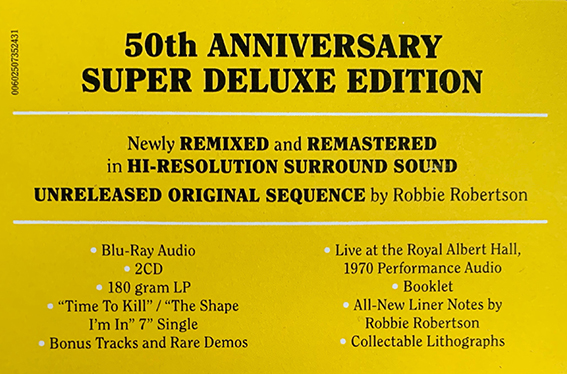
Note: the sticker implies that Albert Hall was 1970. As the back of the box confirms ands we all know – JUNE 1971
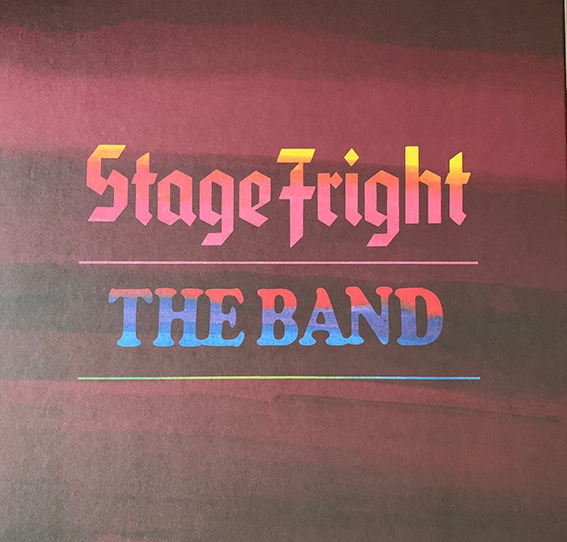
The Box
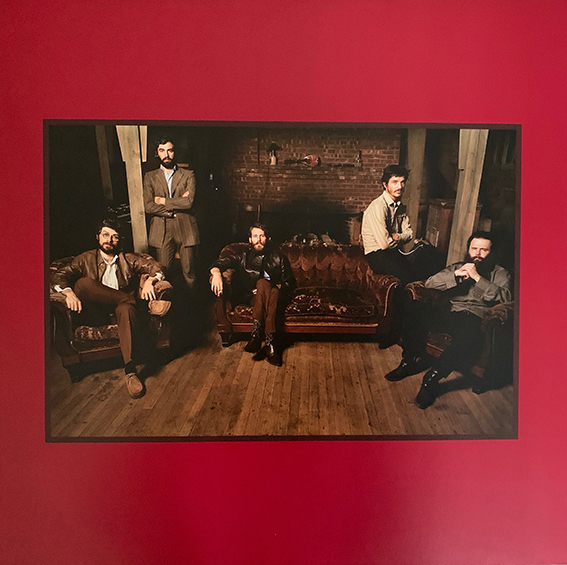
The sleeve for the blu-ray, 2 CDs and 45 disc
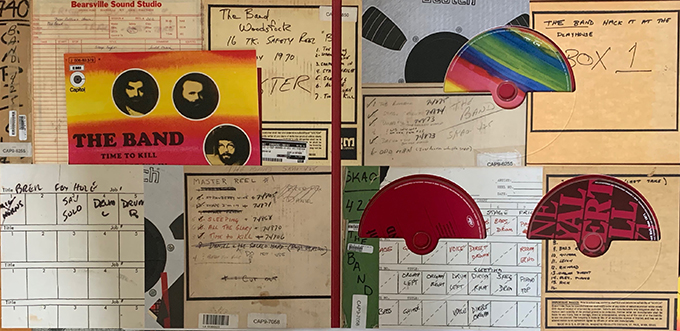
The 45, blu ray and CDs
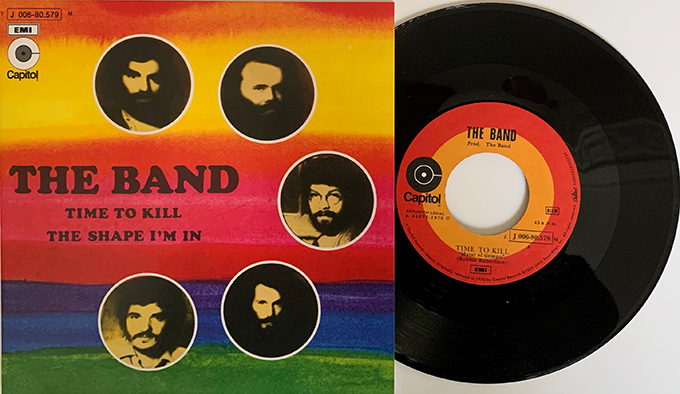
Time To Kill: Spanish 45 replica.
The 45
The Spanish release included in the Super De Luxe Box Set mirrors the US one: Time To Kill / The Shape I’m In. Yes, the better song is on the B-side. The US realized that pretty soon and had a new press advert:
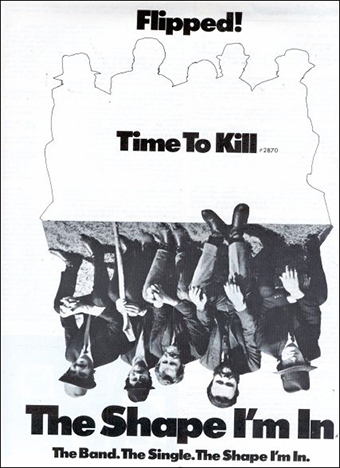
Galleries
The American release Time To Kill / The Shape I’m In. Promo copy. Unusually for 1970, in stereo.
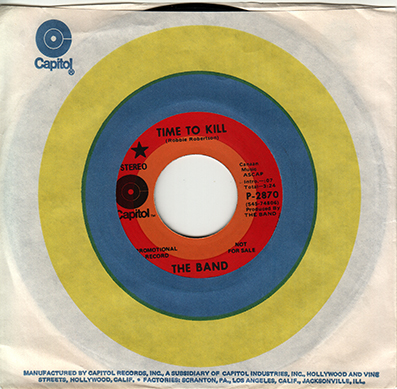
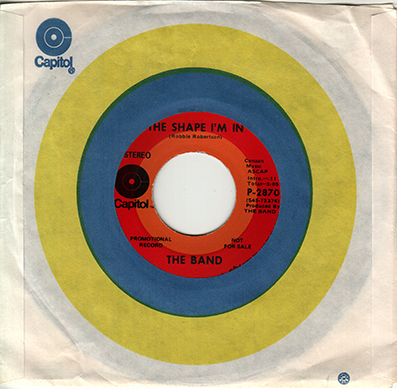
The initial UK release was Time To Kill / Sleeping.
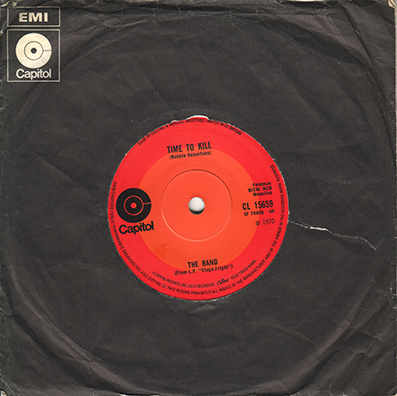
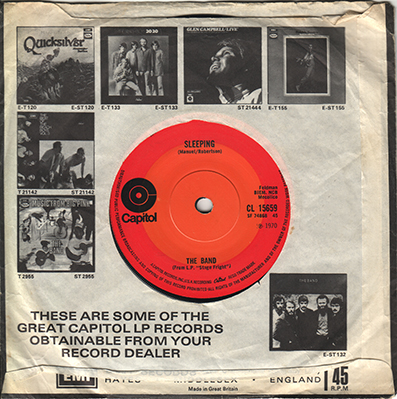
The second UK release was The Shape I’m In / The Rumor.
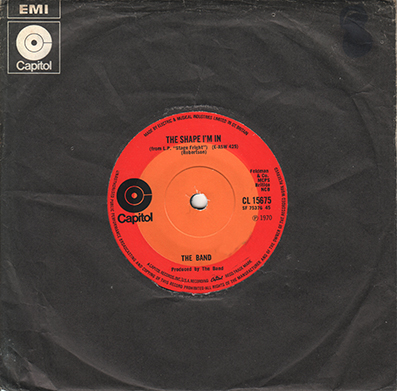
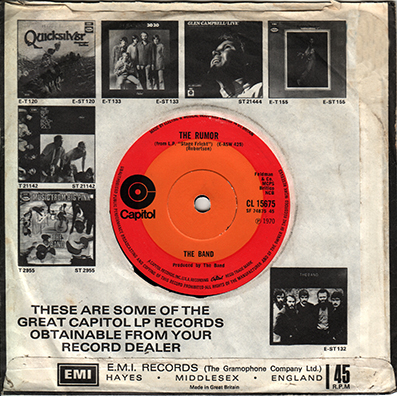
The standard UK Capitol 1970 sleeve advertised the first two Band albums on the reverse.
The CD
Robbie Robertson: The album has become
a whole new listening experience with the original song order and the
depth of these mixes. There may be some purists that prefer “the way it
was” and of course that’s readily available. I’m enjoying this new
version, this new story, this musical journey. It feels like a
fulfilment and I know my brothers in The Band would definitely agree.
Sleeve notes to Super De Luxe Box Set
It’s been remixed by Bob Clearmountain. This is arguable, as it was on The Band aka The Brown Album. Bob Clearmountain is famed for work on so many artists’ work, including The Rolling Stones, Chic and Bruce Springsteen, but also David Bowie’s Let’s Dance, Bon Jovi, Roxy Music. Generally material that rocks harder than The Band, but then this album is ‘rockier’ than the others. Clearmountain certainly exposes more and clarifies (and to me, widens the soundstage, and accentuates separation). Many felt on The Brown Album remasters that the “woodiness” was lost.
The thing about Stage Fright is that apart from Daniel & The Sacred Harp and perhaps All La Glory it lacks that “woodiness” in the first place. This release does have an aspect of those earlier CD adverts of ‘lifting a veil’ from the music.
The New Running order
David Browne: Robbie Robertson would
like to apologize. “I made a mistake,” he says from his L.A. office.
“And now I’m so thrilled that I could undo that mistake and make this
record what I thought it was, and the experience I thought it was…
the running order of those songs, Robertson says, never sat quite
right with him. At that point, the Band were in a fragile state — the
moment “when everything changed for us,” Levon Helm wrote in his
memoir, This Wheel’s on Fire — and for the sake of unity,
Robertson says he began pushing the others in the group to collaborate
on songs with him. They did, to varying degrees, and when Stage
Fright was finished, Robertson put together a track sequence for
the album, which would open with a rollicking tribute to traveling
tent performers, “The W.S. Walcott Medicine Show,” and end with the
slinky, late-night “The Rumor.” “When I first sequenced this record and
listened to it, I thought, ‘What a journey, what a fucking ride this
is,’” he recalls. “And I loved it. They were really doing justice to the
songs I was writing.” But according to Robertson, the other members of
the Band weren’t as enthused and demanded that some of their
collaborative efforts — like “Strawberry Wine,” his co-write with Helm,
and the two Richard Manuel–Robertson songs, “Sleeping” and “Just Another
Whistle Stop” — be moved up in the track sequence. In fact, “Strawberry
Wine” became the opening song. “The guys were like, ‘Man, you know,
some of the songs you were really pushing us for our part, they’re
buried in the sequence,’” he says. “So I thought, ‘Fuck it, I’m
going to push all of that way up front.’ And it was a mistake. We
weren’t falling apart, but we were wrangling and we never had to wrangle
before.”
Rolling Stone, 10 February 2021
On which, Rolling Stone opined back in 1970: The songs Robertson wrote on his own are better than the ones where the other guys helped out. Doesn’t seem right, does it?
John Burks, Rolling Stone 17 September 1970
Basically, side two becomes side one with W.S. Walcott Medicine Show and The Shape I’m In switching places. This is a hard one for me, as I loved the shape I’m In as the first track I played. W.S. Walcott Medicine Show as an opener points the way to Life Is A Carnival as the opener on their fourth and next album, Cahoots.
Side one becomes the second half, with a more radical re-ordering … and Sleeping is a brilliant ender. However, though Robbie Robertson has said that this is a return to the ORIGINAL sequence, in Rolling Stone he suggested that The Rumor was the final song in the original sequence. Not here.
For working out what Robbie Robertson meant by politics dictating the original 1970 order, consider lead vocal as well as songwriter.
2021 50th Anniversary Original album W.S Walcott Medicine Show
(Robertson)
lead vocal: Levon, RickStrawberry Wine
(Robertson-Helm)
lead vocal: LevonThe Shape I’m In
(Robertson)
Lead vocal: RichardSleeping
(Manuel-Robertson)
lead vocal; RichardDaniel & The Sacred Harp
(Robertson)
lead vocal: Levon, RichardTime to Kill
(Robertson)
lead vocal: RickStage Fright
(Robertson)
lead vocal: RickJust Another Whistle Stop
(Manuel-Robertson)
lead vocal: RichardThe Rumour
(Robertson)
lead vocal” Rick, Levon, RichardAll La Glory
(Robertson)
lead vocal: LevonTime to Kill
(Robertson)
lead vocal: RickThe Shape I’m In
(Robertson)
Lead vocal: RichardJust Another Whistle Stop
(Manuel-Robertson)
lead vocal: RichardW.S Walcott Medicine Show
(Robertson)
lead vocal: Levon, RickAll La Glory
(Robertson)
lead vocal: LevonDaniel & The Sacred Harp
(Robertson)
lead vocal: Levon, RichardStrawberry Wine
(Robertson-Helm)
lead vocal: LevonStage Fright
(Robertson)
lead vocal: RickSleeping
(Manuel-Robertson)
lead vocal; RichardThe Rumour
(Robertson)
lead vocal” Rick, Levon, Richard
2021 and 1970 versions compared
The Songs
This will not be the lengthy lyric analysis of my articles at theband.hio.no. Just comments per song, but in the sequence of the 50th Anniversary Edition. The credits on Stage Fright fed the “feud” among Band fans between the”Robertsonians” (who adhered to the auteur theory) and the “Levonistas” who thought other Band members deserved credit for their arrangement, and in Levon’s case for recycling tales and anecdotes he’d told.
It has always been difficult to persuade the Levon fans that in music copyright, the proceeds divide between melody and lyric at half each. Melody is the “top line” only. Arrangement counts for nothing. This is because if we take The Weight, then very different versions by Aretha Franklin, Spooky Tooth, Diana Ross & The Supremes & The Temptations, The Staple Singers, Jackie De Shannon and more than one hundred others are still “The Weight” but they do not have Levon’s drums and vocal or Garth’s piano etc. If you tell me an anecdote and I go and write a novel based on it, I will owe you nothing.
A lot of the feud was fuelled by money, and Stage Fright is where it became apparent. As with so many groups, after a couple of albums, the non-songwriters work out how much more money the songwriter is earning. I would rate Sandra B. Tooze’s superb biography Levon (2020) as one of the better things on The Band and also one of the most pro-Levon. Even then, she details how fast Levon was spending money at the time… in ridiculous sprees of generosity. She also points out that he gave freely, but if loaned money, would not repay it. Rick Danko also described the poisoned chalice of sudden great wealth. If you give five guys a million dollars each in 1970, then come back twenty-five years later, when the 1990s Band were back on the road to pay the bills (without Robbie), it will be no surprise that some are broke and some are wealthy.
Unless stated otherwise:
Robbie Robertson – guitar
Levon Helm – drums
Rick Danko- bass
Richard Manuel- piano
Garth Hudson – Lowrey organ
In the credits to A Musical History it just looks as if the above was cut and pasted in.
Rick Danko’s use of an Ampeg fretless bass guitar was a major innovation on this album.
W.S. Walcott Medicine Show
Levon Helm – lead vocal / Rick Danko- lead
vocal on one verse / Garth Hudson – tenor and baritone saxophones/ John
Simon – baritone horn (trombone?)
John Simon had dropped in to
watch the sessions, but was not comfortable seeing Todd Rundgren in his
producer’s chair. He reprised his horn duetting with Garth on this one.
It’s the only track where Garth plays saxophone, which is unusual.
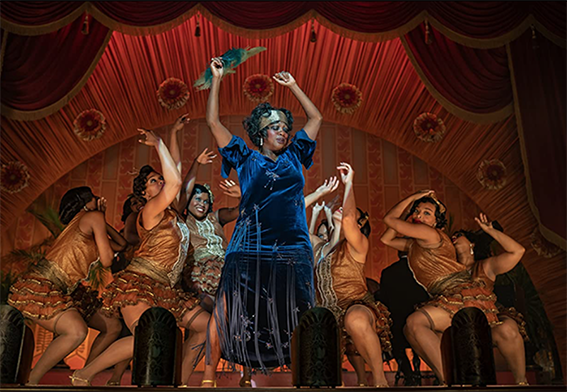
From “Ma Rainey’s Black Bottom” (2020)
This is an obvious opener, as like Sergeant Pepper’s Lonely Heart’s Club Band, it invites you ‘come on out and catch the show’. It prefaces the content. I can even hear Levon in my mind protesting, ‘It ain’t Sergeant Pepper, Robbie!’ when the opening slot was first proposed.
The stories were about F.S. Wolcott’s Rabbit’s Foot Minstrels, though “W” fit the meter better than a single syllable “F.” Ma Rainey, who claimed to have invented the word “blues” worked for F.S. Wolcott’s Rabbit’s Foot Minstrels. She was alleged to have kidnapped Bessie Smith (Bessie Smith is another song by The Band) and taught her to sing the blues. In the 2020 film Ma Rainey’s Black Bottom, a show is seen, and is a raunchy after hours tent show (“You know he always holds it in a tent”) the inspiration for Levon Helm’s later Midnight rambles. Levon may have told tales, but the theme is a constant Robbie one from Life Is A Carnival on the next album to the movie, Carney. He claimed to have worked fairgrounds as a kid.
Robbie has explained that he always veered to narrative story songs until Stage Fright:
Robbie Robertson: In Stage Fright all
that (personal) stuff is starting to creep out and I don’t even want to
let it out! I’m trying to hold it in, but in the end I couldn’t. It was
coming out in the course of all these things that were being written …
in the W.S. Walcott Medicine Show, I was really talking about the same
kind of spectacle that we had become.
Liner notes to 2000 Remaster
Indeed …
‘There’ll be saints and sinners, there’ll be losers and winners.’
The Shape I’m In
Richard Manuel – lead vocal, clavichord
Sung by Richard Manuel, yet in the 1990s Band, Rick Danko made the song his own. In retrospect, Robbie is putting the truth into Richard’s mouth in an overt reference to the problems. Robbie has said that Richard as an alcoholic before he even joined The Band, and that in 1970 he was one of the three heroin users.
While watching Richard pound out the rhythm on the clavichord, I couldn’t help but see the irony as he sang out, ‘Oh, you don’t know, the shape I’m in.
Robbie Robertson. Testimony, 2016
The instrumentation is one of the reasons this is among the very best Band songs. What makes it is the incessant rhythm, held by guitars and drums.
Sandra B. Tooze: The Shape I’m In
features three distinct drum parts.Levon plays a quarter note groove
with the ride cymbal, he switches to half time where he orchestrates the
toms, and he doubles up and goes onto an eighth note groove with
quarter tone backbeats. It was this track that led a Rolling Stone
reviewer to anoint Helm as “the best drummer in rock ‘n’ roll.”
Sandra B. Tooze, Levon, (2020)
I admit that’s beyond me technically, but the rhythm guitar supports it all the way. Go down town there’s a rumble in the alley … the rhythm section are like three turkey cocks strutting into town. Then Garth’s organ is extraordinary, as are the snatches of lead guitar. Garth’s tone and exploration poits the way forward to his later masterpiece, Jupiter Hollow.
David Lewis: The
lyrics are, as so often in Band songs, full of Christian and Biblical
allusion: ‘Peace in the Valley’ is one of the great Protestant hymns.
(Incidentally, Elvis sang it on one of his Ed Sullivan performances).
The lack of redemption is stated right in the first verse: the opening
couplet states that to go anywhere else, peace would be achieved.
However, stuck down town, it’s a fight for survival. The protagonist’s
wife/girlfriend has left, presumably in despair, and it hasn’t improved
his position any.
David Lewis, article on The Band website on the song.
Daniel & The Sacred Harp
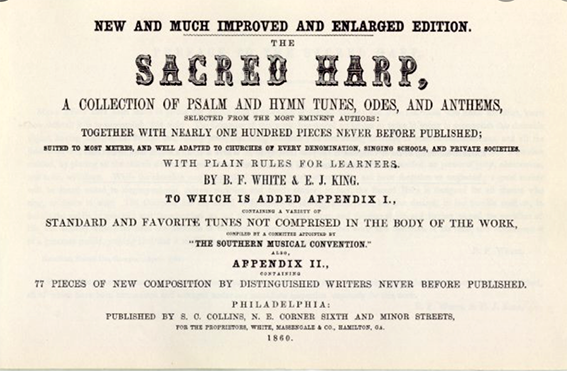
Levon and Richard – lead vocal / Levon – 12 string acoustic guitar / Richard Manuel drums / Rick Danko – acoustic bass, fiddle / Robbie Robertson – electric guitar, autoharp
Levon is the narrator, and Richard is “Daniel.”
This is surprisingly a love it or hate it song. I’m in the love it group. It is the song that sounds most like The Band (aka The Brown Album). It’s also one they would have found it hard to play live – Rick Danko would have needed four hands to play bass and fiddle, though as the 90s Band proved on one song, Levon was a good bass guitarist. Its lack of later live versions means it’s a lesser known one. My essay on the lyric is extremely long. I’ll extract a few lines. Like the opening line of The Weight it sits in the middle of Biblical and contemporary. It’s a landscape that has that quintessential American bird, the whippoorwill, and also The Sea of Galilee.
The Sacred Harp sounds Biblical with strings. Robbie has said it’s based on Sacred Harp shape-note singing. Shape-notes are do-re-mi-fa-sol-la-ti notated by different shapes of the note head. The notation was described in B.F. White’s 1844 primer, The Sacred Harp:
Jim Carnes: By virtue of its
comprehensiveness and of White’s wide personal influence, this songbook
eclipsed all others in the South and earned a place of honor in most
homes second only to that of the Bible.
Jim Carnes, ‘The Tradition’, Nashville, 1989
Thee was also ‘The Colored Sacred Harp’ around the same time. I don’t think this meant they used colours for notation. This Daniel isn’t the Biblical prophet from the lion’s den, but the name sounds solidly Biblical. The setting of the song places us in an Old Testament landscape. The song is based on the Faust story, in its American incarnation, Robert Johnson’s blues, where the artist trades his soul for the ability to play.
Robbie Robertson: I
was so obsessed that I was stealing everything in sight. From, Fred
Carter, Roy Buchanan, the Howlin’ Wolf records. I came a long way in a
short time, and people used to kid me, saying, “What is it with this
guy? Did he sell his soul?” Years later I wrote Daniel
& The Sacred Harp and it was based on this whole mythology.
Quoted by Barney Hoskyns, in Across The Great Divide.
The diabolical pact is there: When he looked to the ground, he noticed no shadow did he cast. This is the punch line, and the sombre tone of the music lets us know that Daniel has realised the price is his soul.
The copyright lines on Stage Fright read … Canaan Music.
Stage Fright
This song continues the story, and you can see why the original order broke it up by putting W.S. Walcott’s Medicine Show in among these three linked songs:
They gave this ploughboy his fortune and fame
Since that day he ain’t been the same
It has to follow the singer selling his soul in the previous track, it has to connect to the shape the singer’s in, in the one before. Both Levon and Rick had ridden a plough too.
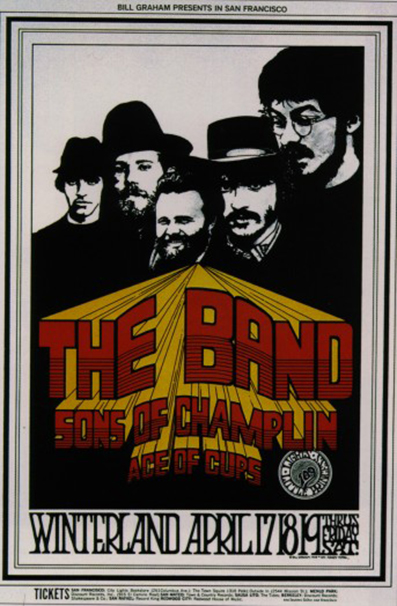
So it links to the Band and the effect of money. On the surface, there’s a link to The Band’s first concert as “The Band” at Winterland, San Francisco. Robbie fell dramatically ill just before, and only managed to perform with a hypnotist standing in the wings. Rick Danko was chosen to sing it, not a man I ever thought had experienced fear of performing in his life … but he has the emotion in the voice.
Robbie Robertson:
It was named after the experience of having put ourselves in the public
eye, but we were kind of private people at the same time. Taking our
music out and performing it, there was something very private about it,
and the way that we performed was not flashy or showy … it was almost
more like classical music in performance than coming out and wearing
cut-off leotards and buckskins. We’re not here for nonsense. We’re not
here for people to get drunk while we’re playing anymore. We wanted to
shed that skin. It all added to this kind of stage fright thematic thing
in our lives.
Quoted in The Band: A Musical History Box Set
There was an aspect there in 1971. A friend described a German concert on the tour where Robbie hit a bum note, and everyone on stage glared at him, and he shrugged apologetically.
Part of the Band’s myth (and it is a myth) was the band of brothers that had played together for years, played every bar and honky tonk (for people to get drunk too), hardened road veterans. It doesn’t count the fact that Levon jumped ship from the Dylan tour for nearly two years. Or that in (say) 1972, they didn’t play once. Hardest working band in the business? Someone did a check on their busiest years, 1970, 1971, 1974 and 1976, and compared to most bands they really didn’t play often at all.
Take 1970, one of the Band’s busiest
years. Checking Setlist.Com I found 53 gigs in the year. I was counting
roughly. A better check gives 50 gigs.
Compare: In 1971 Uriah Heep played 227 gigs in the year.
Dag Braathen added: 41 of the 1970 Band shows were either on a Friday, Saturday or Sunday so they were pretty much weekend warriors.
So…maybe they did have stage fright!
The Rumor
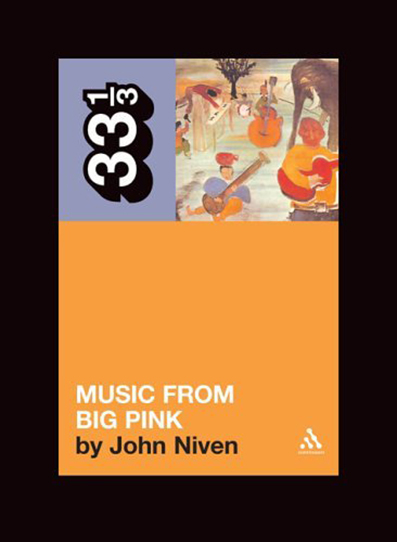
Originally in that King Harvest / River Hymn final position. It has the great vocal swapping, it has some of Robbie’s most gently stinging guitar interventions. John Niven’s novel Music From Big Pink (MY REVIEW is here) inhabits the incestuous nature of the Woodstock gossip mill:
Informed by extensive research and interviews with surviving Band members Levon Helm and Garth Hudson, Music From Big Pink is a factional book; a place where fictional characters rub shoulders with real people like Richard Manuel, Rick Danko and Albert Grossman, and where actual documented events thread their way through the text alongside imagined scenarios.
The narrator (and also the author) regards Richard and Rick with the most affection. Levon is a “character”, Garth is remote but a genius and Robbie’s the leader, the toughest emotionally and ultimately, the winner. Years of reading the Band Guestbook indicates that this is the generally-held view.
But The Rumor is also a high note to end the original album on:
Open up your arms, feel the good
It’s a-coming, a brand new day!
As Robbie says it was always intended as the ender, I guess it’s here as track five because it is part of that side two “set.” The whole set, in retrospect, is about “being in The Band.”
Time To Kill
Rick Danko – & Richard Manuel- lead vocal, Levon Helm- rhythm guitar, Richard Manuel- drums, Garth Hudson – piano
Originally the rollicking first single, now the track that opens side two if you have the vinyl version. Playing the new edition this last few days, it’s the constant earworm. In the past, I’ve lumped it with Just Another Whistle Stop and Strawberry Wine as among the three weaker songs … though the strongest of the three (if that makes sense). Levon’s second guitar grumbles and struts beneath Robbie’s lead. A great combination which is not listed on a Musical History but which Sandra B. Toove’s book states. It’s a piano sampler too, but with Richard on drums, this is Garth on piano, as you can tell immediately when it starts seeking snaking routes away from the base line.
It sounds like domestic bliss in at home, in contrast to the disharmony at work for Robbie.
Just Another Whistle Stop
A Richard Manuel collaboration with Robbie, sung by Richard.
It opens with a harmonic laden four bar guitar intro,
variations of which occur before subsequent verses. (It) is rife with
both time and key changes and contains a full-blooded extended guitar
solo, the likes of which Robbie had generally avoided in The Band’s
recordings up to this point … the flanging sound on Robbie’s guitar was
the product of an arcane tape effect that engineer Todd Rundgren brought
to the party.
Rob Bowman, liner note to 2000 Remaster issue
Todd Rundgren has complained elsewhere that the album gave him little chance to use his studio tricks and gimmicks. Well, he did here. To be honest, the words don’t make much direct sense, but that’s a tradition extending to We Can Talk and Chest Fever.
All La Glory
Levon lead vocal. Garth Hudson – accordion. Robbie Robertson – electric guitar played through a Leslie speaker, slide guitar.
It’s directed at Robbie’s first-born daughter. A lullaby, and it’s “la” glory in tribute to Dominique Robertson, who is French-Canadian. Levon nails the tender vocal perfectly, even if it’s ostensibly so well out of his expected style. Garth weaves the accordion through it.
Robbie Robertson: Levon’s performance
on it was extremely touching. The sound of his voice and his phrasing –
pure talent. Next Levon and Libby Tutus announced that they were
expecting a little one.
Testimony, 2016
Strawberry Wine
Levon Helm – lead vocal, rhythm guitar, Richard Manuel- drums
Levon Helm co-wrote it with Robbie. He brought it back after a road trip home to Arkansas. Robbie says he was enthusiastic in persuading Levon to contribute to writing. It is easily the weakest song on the album, being no more than a lively but generic R&B song. Levon’s later Sweet Peach Georgia Wine from American Son is a better song if you want to sing about sickly sweet fruit wines, but then he didn’t write it. However, it really comes into its own live. See below. Rick’s plunging, burbling fretless bass is the best part of it.
Sleeping
A Richard Manuel- Robbie Robertson collaboration.
It’s very much a plaintive Manuel melody, so I’d guess a direct music / lyric division. Robbie mentions the sessions with Band members sleeping on the job.
Robbie Robertson: To look around and
see people nodding out in the midst of writing a song with Richard
called Sleeping is incredibly confessional. I’m sorry!
Liner notes to the 2000 Remaster
It works as a low key ender, though The Rumor was perfect.
The Bonus Tracks
The Band have never been great on bonus tracks. They exhumed what they had for the 2000 Remaster series, but unlike Bob Dylan, they never accumulated piles of unreleased material, nor did they mess around with many retakes. Judging by previous bonus tracks, their choice of which version to release was invariably correct.
We get two alternate takes here, and a rough field recording. I don’t think any would constitute a reason for purchase except among the diehard fans.
Strawberry Wine is just Levon and guitar. I’d say ‘demo’ was a more accurate description than Alternate Mix, though “mix” suggest it’s isolating Levon and his guitar from the main mix.
Sleeping sounds more like isolating the Richard Manuel vocal and piano.
Strawberry Wine
(Robertson- Helm)Alternate Mix Sleeping
(Manuel-Robertson)Alternate Mix Get Up Jake #1
(Robertson)Calgary Hotel Recording Get Up Jake #2
(Robertson)Calgary Hotel Recording W.S. Walcott Medicine Show
(Robertson)Calgary Hotel Recording Rockin’ Pneumonia & The Boogie Woogie Flu
(Huey Smith)Calgary Hotel Recording
Huey ‘Piano’ Smith coverCalgary Blues
(Robertson)Calgary Hotel Recording
Richard Manuel: harmonicaBefore You Accuse Me
(Bo Diddley)Calgary Hotel Recording
Bo Diddley coverMojo Hannah
(Clarence Paul – Andre Williams)Calgary Hotel Recording
Bonus tracks on the 2021 Stage Fright CD
These were recorded on a portable cassette recorder in a Calgary Hotel in 1970 on the Festival Express Tour. On this tour Rick Danko was memorably on the train giving a drug-fuelled singing tutorial to Jerry Garcia, with the assistance of Janis Joplin. (see the DVD).
Robbie was in the Calgary hotel, showing a new song, Get Up Jake. Here the party that assembled in the hotel consisted of Robbie on guitar and vocals, then Rick Danko arrived with Eric Andersen, and Rick sang harmony vocals and rhythm guitar, and later Richard joined in on harmonica ad vocals. That’s what it says. Rick certainly sings at least one verse of Get Up Jake on lead vocals.
Rockin’ Pneumonia & The Boogie Woogie Flu dates back to 1957, by Huey Piano Smith, and was covered by Larry Williams at the time. The big hit US version by Johnny Rivers came two years after this session. The Flamin’ Groovies had covered it in 1969. I was surprised that Wiki has nothing on British cover versions … it was a live staple for British R&B bands, especially those with a piano. Georgie Fame used to do it, as did P.J.Proby. I have a feeling Zoot Money did it live … more recently he recorded it with Alan Price. It wouldn’t be surprising if The Hawks – who always had a piano player – had done it live.
Calgary Blues is the kind of make it up as you along blues that I’ve seen bands do at jams and while travelling.
Before You Accuse Me is a song that may date to Levon & The Hawks and earlier … The Hawks were Bo Diddley specialists with a vengeance.
Mojo Hannah is especially interesting as a choice of cover, because the best known version, by Tammi Lynn was recorded a year later. The song was first by Henry Lumpkin in 1962, then recorded by Marvin Gaye, by Esther Phillips and by The Blues Project.
The LP
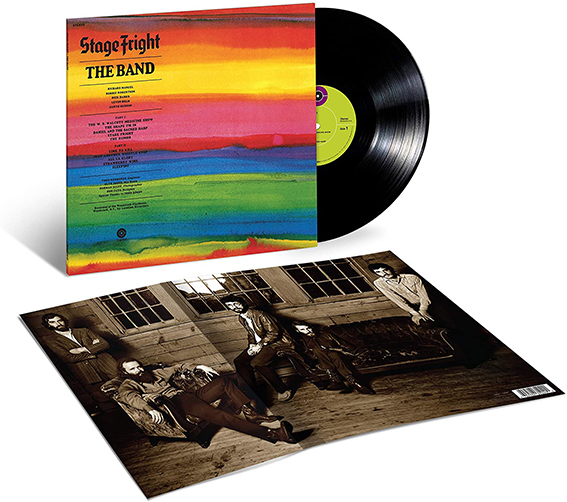
The LP included in the box set, and the standard LP issue
Beautiful as a possession. I would say to analogue purists, that by the time something has been this extensively remastered the original “AAA” analogue mystery has long since left the grooves. Yes, original LPs sound different to CDs, just as original 45s sound different to LPs. It’s compression, mastering, pressing. By the time they’d remixed and widened this one, it’s well into the digital domain. Great if you prefer playing LPs – I do too … on originals.
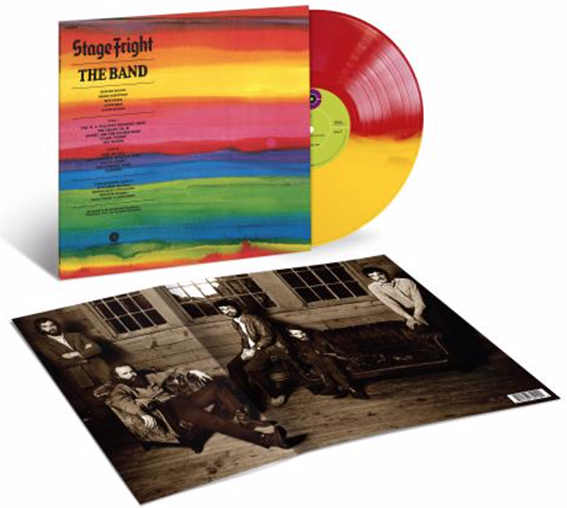
If you only want a vinyl copy, you can get a red and yellow vinyl copy, if you want to pay £34.99 instead of £17.99 for a black vinyl one. You get the black one in the box set. It depends how they did it. Some esoteric turntable sites argue over black and coloured vinyl. Some believe that the carbon in black vinyl causes an interference in the electrical field, and that clear vinyl is better. Others will add that as in the very early days of 45s, colours are better than black. Then again some people believe that sticking bits of silver foil on your mains plugs improves sound. Others believe that chanting OM for five minutes and deep breathing improves it even more. Others believe in herbal or medicinal enhancement.
Robbie Robertson has opted for clear or white vinyl, as well as 45 rpm instead of 33 rpm in the past. All agree that picture discs are a degradation of the signal. This is red on one half, yellow on the other. I haven’t got one.
The Blu-Ray
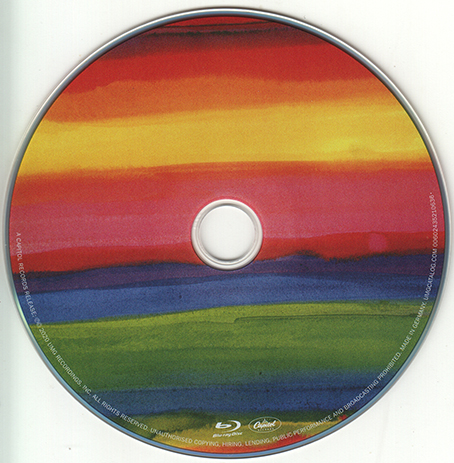
Stage Fright: BluRay
I don’t know about you, the reader, but for me, it is difficult to compare blu-ray and CD because most people will be playing them through a totally different system. My main system has an audiophile pre-amp (i.e. no tone controls, no loudness control) and power amp (Myrad). It runs through big Mission speakers that are more than a quarter of a century old. The CD player is an Arcam CD / SACD player, recently replacing the Myrad that died. The turntable is a Goldring. Yes, you have to lift the platter to change speeds, and there’s no auto-lift. So it’s a straight stereo system.
It sits right next to the M&K 5.1 system (which actually has more expensive speakers, but they’re 5.1 speakers). The M&K subwoofer was chosen for music. Most subwoofers were designed for crashes and explosion and made a pig’s ear of bass guitar. The M&K was chosen because it renders bass guitar beautifully. Then there’s a Sony blu-ray player and a matched Sony surround sound amplifier.
Basically, it is not a head-to-head comparison, and it never is, though of course the Sony blu-ray player can also play a stereo CD, and most Blurays of music albums have a hi-definition stereo mix as well as a surround mix.
The Blu-ray contains both albums … Stage Fright and Royal Albert Hall, in two kinds of 5.1 surround sound and PCM stereo.
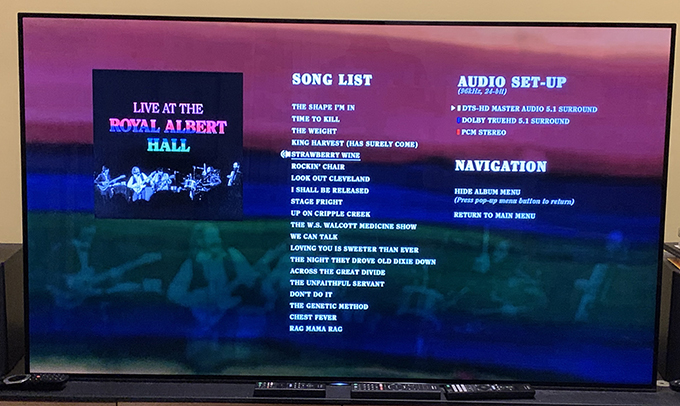
Blu-Ray menu: Royal Albert Hall
I found the RoyalAlbert Hall set more enthralling (both are enthralling), probably because it didn’t interfere with familiarity and pre-conceptions, and the sheer volume and attack of a 5.1 system right round you benefits. The Weight from Royal Albert Hall is truly stunning, especially in 5.1. It’s slightly different … piano and organ are both up loud. Additional voices come in additionally on lines where they don’t on the original.
Royal Albert Hall
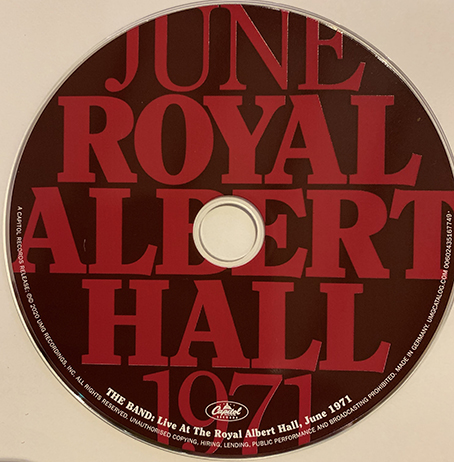
The official Royal Albert Hall CD
SONG ORIGINAL ALBUM The Shape I’m In Stage Fright Time To Kill Stage Fright The Weight Big Pink King Harvest (Has Surely Come) The Band Strawberry Wine Stage Fright Rockin’ Chair The Band Look Out Cleveland The Band I Shall Be Released Big Pink Stage Fright Stage Fright Up On Cripple Creek The Band The W.S. Walcott Medicine Show Stage Fright We Can Talk Big Pink Lovin’ You Is Sweeter Than Ever Four Tops cover The Night They Drove Old Dixie Down The Band Across The Great Divide The Band The Unfaithful Servant The Band Don’t Do It Marvin Gaye cover The Genetic Method Live speciality Chest Fever Big Pink Rag Mama Rag The Band
The Royal Albert Hall: June 1971 CD
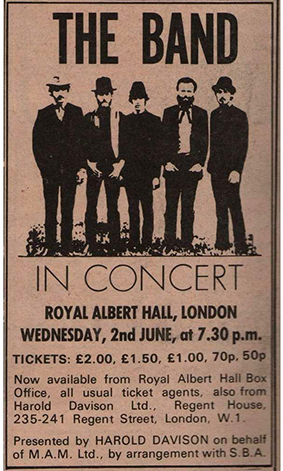
The legendary concert. And I never got there. Tickets started at 50p and went up to £2. Todd Rundgren was in attendance to mix the live sound on the night.
Three tracks had appeared on the box set The Band: A Musical History: Strawberry Wine, Rockin’ Chair and Look Out Cleveland – well-chosen in they’re the ones that don’t turn up on other live albums.
Jem Aswad: But the real prize here is a previously unreleased
full — and stunning — June 1971 London concert that captures this
formidable group of musicians in rare form. It includes stellar versions
of virtually every song from the group’s first three albums that fans
could want to hear … By this point, the songs had been thoroughly
broken in, and the band members allow themselves instrumental flourishes
that aren’t present on the studio versions. Nobody shows off (it
wouldn’t be the Band if they did), but Hudson in particular takes some
soaring solos that are completely otherworldly but still retain a
connection to the songs’ melodies; likewise, Robertson and Danko
punctuate the songs with tasteful Telecaster mastery and bass fills.
It’s a lasting monument to the group’s world-class musicianship.
Variety, 12 February 2021
Well, not “full” quite …
I had an audio tape from an audience recording years ago, then a bootleg CD turned up – the same source. This official release is the proper 4 track recording made by EMI, and is vastly superior altogether. It doesn’t seem to have been a full-on attempt to do a live album, either that, or EMI in their meanness, didn’t want to go beyond a four track master. It’s said to be the only official recording of the Summer 1971 tour. Other audience tapes exist though … Rotterdam was one. Presumably, the Royal Albert Hall was chosen as a show to record because of its proximity to Abbey Road recording studios. Few would choose the Albert Hall for sound quality. It was notoriously bad for years until they fitted a series of circular baffles hanging from the dome. This is great recording quality, but I’d assume it was a direct feed from the desk. Rick Danko’s fretless bass rolls away and is awesome. Unlike the Dylan recordings from 1966, you can really hear Richard Manuel’s piano work. I think the ability to record piano in a group context had improved markedly in the five intervening years.
There’s a thought. When Garth Hudson played in support to Mercury Rev at the Forum in 1999, three of us from The Band website met up at their hotel. It turned out that the van they’d hired only had three seats … Randy Ciarlante, Aaron Hurwitz and Ms Marie Spinosa, who were accompanying him. Confusion reigned until someone asked if anyone had a car and was willing to drive Garth and Tom, the Woodstock Records manager, to the gig. My car was right outside. Garth carefully wrapped his saxes in coats (including mine, I felt honoured) before consigning them to the boot. Then they expressed a strong desire to see … The Royal Albert Hall and Abbey Road Studios, so we did, though Garth fell asleep. I still blush at my inability to find Abbey Road easily, in spite of spending many days at a friend’s home in Belsize Road in the 60s. The road system had changed, I insist. Anyway, we did talk about the 1966 and 1971 gigs at The Royal Albert Hall.
The power of the Summer 1971 tour is that the set included several songs which were to drop out of their setlist by the time they reconvened in 1973. They performed five songs from Stage Fright. Three survived to later incarnations 1990s of The Band … The Shape I’m In, Stage Fright and W.S. Walcott Medicine Show. Time to Kill was still around in 1974 when they played Wembley (I was there) but inexplicably Strawberry Wine got dropped. The live version excels, and is better than the studio cut. That’s down to the commitment and urgency of Levon’s vocal, but most especially Garth Hudson’s truly wild organ part. The original vocal was, ‘laconic.’ In the 1990s, when some of us complained at the number of generic R&B songs in The Band’s setlist, I often wondered why Strawberry Wine was never performed. Levon Helm co-wrote it and … well, it does fit the “generic R&B” category.
Then there are other greats that got dropped from later setlists. In retrospect, it seems to have been Richard Manuel’s subsequent “unreliability” that caused songs to be dropped. Well, they’re here and they’re stunningly good … Rockin’ Chair, King Harvest, We Can Talk, Across The Great Divide, I Shall Be Released. Again in the 90s, I always wondered why Rick Danko didn’t do more of them. He took over The Shape I’m In seamlessly in the 90s Band.
Then you get others they dropped … Look out Cleveland would surely have fit the 80s and 90s versions of The Band.
The closing number is Rag Mama Rag, which would be in deference to its status as their biggest British hit … UK #16, The Weight was UK #21. It’s very different, piano led. Nowhere near as much jug band as the original or even later versions.
The bootleg version…
But was it the closing number? Not according to the bootleg CD Royal Albert Rags which has been circulating for years. There is no comparison in quality – the audience member sounds a long way back and high up and thin sounding on the boot. Royal Albert Rags has a specific date: 2nd June 1971. There were two shows, 2nd June and 3rd June. The easiest way to record would be to spend the first show getting the levels right and mainly going for the second show. The box set simply states “June 1971.”
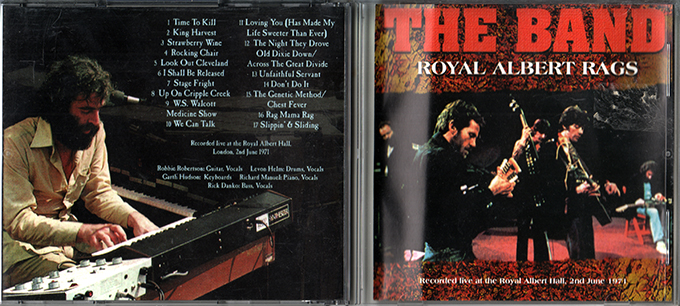
The two shows differ. The bootleg CD has the same running order as the official CD, but skips the first song, The Shape I’m In and the third, The Weight. But then it adds a second encore, Slippin’ and Slidin’, a favourite Band end number.
The 50 th anniversary CD runs to 80 minutes exactly, which is the maximum length for CD so cannot accommodate Slippin’ and Slidin. They decided to drop the last number. Something had to go. I had suspected the bootleg dated back to 76 minute CD blanks or even the earliest 72 minute CD blanks, but not so – it’s 78 minutes, two minutes short of the magic 80.
On the 50th Anniversary CD the Genetic Method is 4 minutes 16 seconds, Chest Fever is 5 minutes 11 seconds. Together 9 minutes 27 seconds. On Royal Albert Rags the combination runs to 12 minutes 40 seconds. Ah. There’s no audience noise at the start on the bootleg, which suggests it might have been mixed in to the official release. On the boot Garth plays for 7 minutes 39 seconds before the chords for Chest Fever, rather than 4 minutes 16 seconds. These indicate two different shows.
The cassette tape of 2nd June is missing The Shape I’m In and The Weight and also Strawberry Wine (which is on Royal Albert Rags) and including Slippin’ and Slidin’. The cassette box noted that these three songs were omitted. It runs to 75 minutes.
The cassette of 3rd June runs to 90 minutes, and includes Slippin’ and Slidin’. I’m not going to dig it out, but it figures this is mainly what goes on the official CD.
I guess judicious editing got it to the magic 80 minutes.
According to Geoffrey Cannon’s Guardian review of the original, someone shouted out ‘Rock ‘n’ Roll!’ before the encore and Robbie replied, ‘The last time we were here you booed us.’ That didn’t survive.
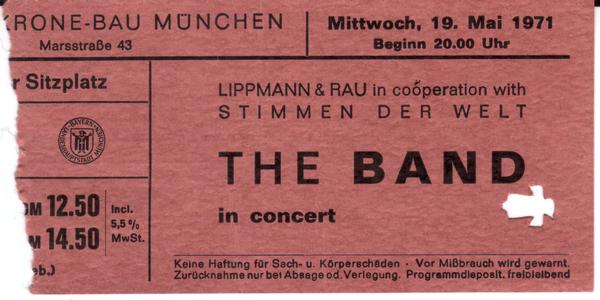
A friend’s ticket from Munich on the tour
Audience cassette tapes exist from Frankfurt (May 20th 1971), Copenhagen (27th May 1971), Rotterdam (6th June 1971) and they all add This Wheel’s On Fire after Slippin’ and Slidin’. However, it’s not on any cassettes of the Royal Albert Hall show.
Other Sleeves
Nearly every country stuck with the great Stage Fright sleeve. Two exceptions were France (insistent as ever on a bad photograph) and Mexico.
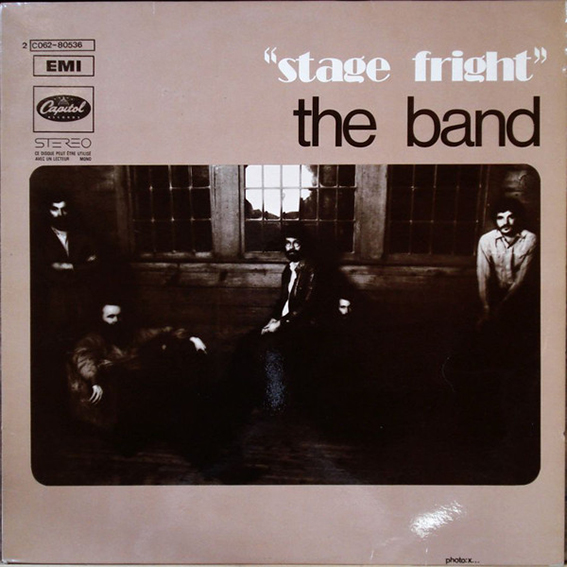
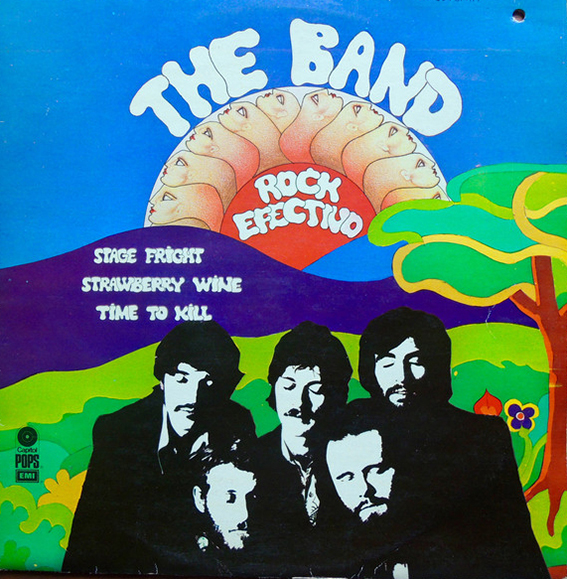
Webmaster